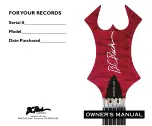Reviews:
No comments
Related manuals for Bluegrass Resomaster

ASM One
Brand: B.C. Rich Pages: 8

Deluxe Nashville Tele
Brand: Fender Pages: 2

Predator
Brand: Peavey Pages: 1

Silent Guitar SLG-120NW
Brand: Yamaha Pages: 16

Standard Stratocaster
Brand: Fender Pages: 1

Standard Jazz Bass V
Brand: Fender Pages: 1

Mark Knopfler Stratocaster
Brand: Fender Pages: 1

Nashville Tele
Brand: Fender Pages: 1

Jeff Beck Stratocaster
Brand: Fender Pages: 1

Jaco Pastorius Jazz
Brand: Fender Pages: 1

Jaco Pastorius Jazz Fretless
Brand: Fender Pages: 1

J-Bass Special 27-6400
Brand: Fender Pages: 20

Stryker TCS
Brand: Warwick Pages: 1

CPX15II
Brand: Yamaha Pages: 1

BEX
Brand: Yamaha Pages: 1

Electric Bass
Brand: Yamaha Pages: 9

ESCAPE CLASSICAL
Brand: TRAVELLER GUITAR Pages: 7

XBOW SERIES
Brand: SONICCOUTURE Pages: 22

















